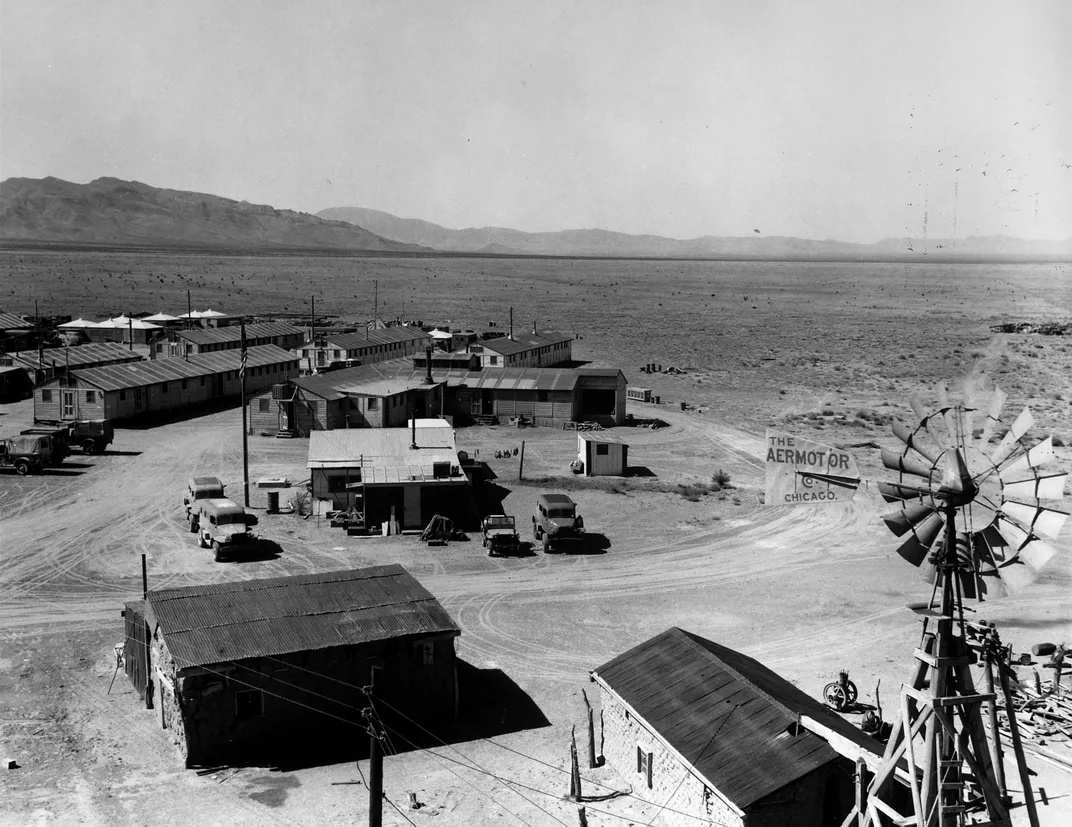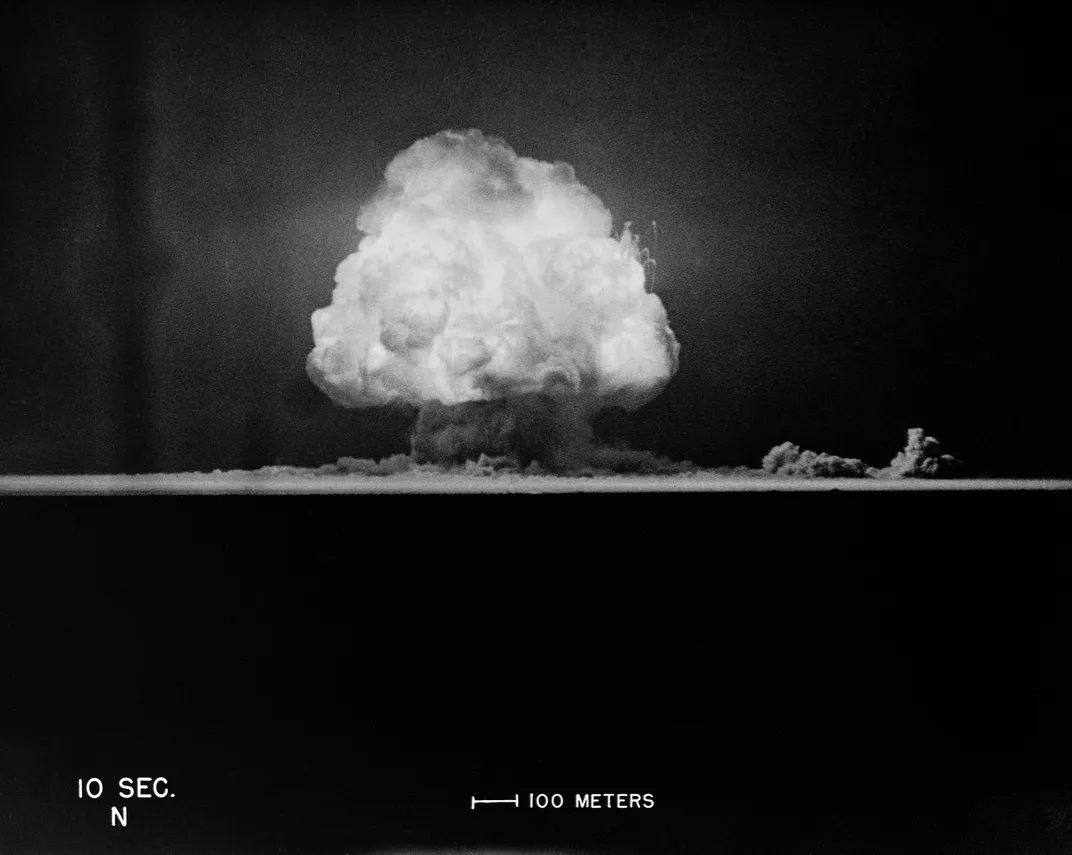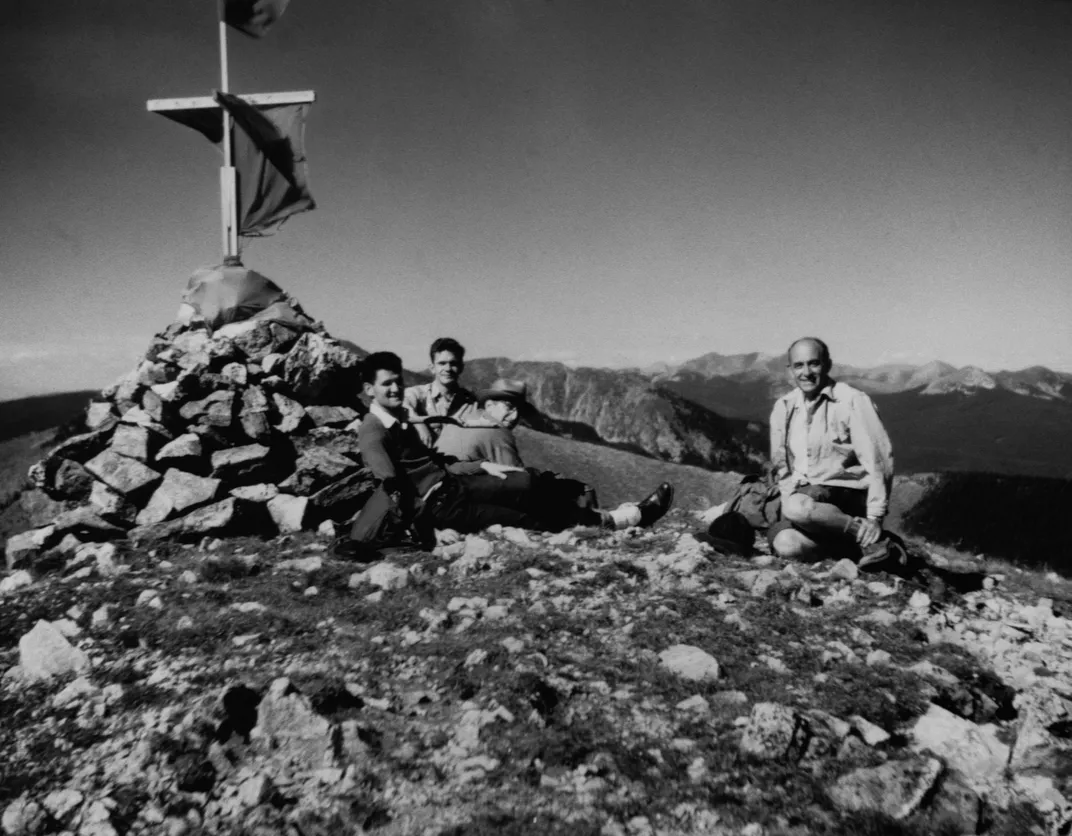One of the Last Living Manhattan Project Scientists Looks Back at the Atomic Bomb Tests
Peter Lax was just a teenager when he went to Los Alamos to join the team that developed the deadly weapon
:focal(415x140:416x141)/https://tf-cmsv2-smithsonianmag-media.s3.amazonaws.com/filer/f5/48/f548ffb2-bb7d-4204-a795-6175b0a08cbf/manhattan.png)
For the elite scientists, engineers and military brass of the Army’s remote nuclear weapons facility at Los Alamos, New Mexico, the night of July 15–16, 1945, was one of excruciating tension.
The world’s first atomic bomb, nicknamed the “Gadget,” was scheduled to be tested at a carefully selected site code-named Trinity in a barren valley near Alamogordo, New Mexico, 200 miles south of Los Alamos. It represented the culmination of the Manhattan Project, the massive, top-secret effort mobilizing American scientific ingenuity and industrial might to produce a superweapon unlike any the world had seen. Sparked by a 1939 letter from Albert Einstein and physicist Leo Szilárd to President Franklin D. Roosevelt warning of Nazi Germany’s nuclear weapons potential, the project was fully authorized in 1942 and would eventually employ hundreds of thousands of people across the nation, few of whom had any inkling of the goal of their labors.
Today, those few who are still alive are a rare breed. Among them is Peter Lax, a 94-year-old mathematics genius and retired professor at New York University, who at the time of the Trinity test was just a 19-year-old corporal stationed at Los Alamos. Recruited for his already-evident mathematical prowess, Lax was far from a key player in the development of the bomb, but his memories of the time shed light on the challenge facing the scientists, many of whom had fled Hitler’s Europe and found refuge in the United States.
“There was a feeling of great urgency,” Lax says today of the Manhattan Project. “At the outset, we didn’t know how far along the Germans were with the bomb. As it turned out, not very far at all. But we felt as if the fate of the world was in our hands.”
I first knew Peter as the endlessly interesting, witty and tolerant dad of my best friend in high school, John, who was killed in an auto accident at 27; and his kid brother, James, who became a physician. Peter’s late wife, Anneli, a fellow mathematics professor at NYU, was also a remarkable person, and the Laxes became a kind of surrogate family for me, as they were for many people; such is the warmth and generosity they unfailingly radiate.
In sitting down with Peter in James’ Manhattan apartment, I came to learn how he escaped the Holocaust as a Hungarian Jewish teenager and just three years later, joined the team that tackled one of science’s greatest challenges, spawning an era of new ones in the process.
**********
In the weeks leading up to the first atomic bomb test, the thousands of men and women sequestered at Los Alamos, including Lax, had accelerated their efforts. The device was assembled and transported to the Trinity site. There was enormous pressure: With World War II still raging in Asia and the Pacific and the geopolitical fate of a devastated Europe in flux, the stakes were sky-high. On July 17, President Harry S. Truman, only a few months into office following the death of Franklin D. Roosevelt, would begin meeting with Churchill and Stalin at the Potsdam Conference, which Truman had delayed pending the results of the bomb test. With Germany defeated, Truman spelled out the Allies’ demand for Imperial Japan’s unconditional surrender, warning of “prompt and utter destruction.”
On the night of the Trinity test, many of the project’s leading lights—an extraordinary concentration of talent that included reigning and future Nobelists such as Enrico Fermi, John von Neumann, Eugene Wigner, Hans Bethe and the young Richard Feynman—were gathered with the project’s scientific director, J. Robert Oppenheimer, and its military chief, Major General Leslie R. Groves Jr., at Base Camp S-10, about 10,000 yards away from the imposing steel structure where the “Gadget” had been mounted. Anxieties mounted further as a violent thunderstorm lashed the valley, threatening to derail the schedule. As the hours passed, Oppenheimer consulted the project meteorologist for updates and calmed himself reading the poetry of Baudelaire. Word came that the storm would pass. The order was given to start the countdown.


“Silence reigned on the desert,” historian Robert Leckie recounts in Delivered From Evil: The Saga of World War II. “Observers not at S-10 lay down in assigned trenches in a dry abandoned reservoir….They waited. A voice like the voice of the Creator spoke from above the black clouds: ‘Zero minus ten seconds!” A green flare exploded in the darkness, illuminating the clouds before it vanished. ‘Zero minus three seconds!’ The silence deepened. In the east was the first pink blush of dawn.” The clock read 5:29 a.m., July 16, 1945.
“And then out of the bowels of the earth there shot into the sky the herald of another dawn,”” Leckie writes, “the light not of this world but of many suns in one.”
A brilliant flash of white light filled the sky, morphing into a rapidly billowing orange fireball that dissolved skyward, tinged in violet and black, rising to 41,000 feet. Soon a tremendous explosion of sound crashed against the barren landscape, followed by thunderous echoes across the valley and beyond. The bomb had unleashed its terrifying power. The world had crossed the nuclear threshold.
Awed by what he had witnessed, Oppenheimer famously quoted from the Bhagavad Gita, the Hindu scripture: “Now I am become death, the destroyer of worlds.” In their Pulitzer Prize–winning biography of the scientist, American Prometheus, authors Kai Bird and Martin J. Sherwin recall the more pedestrian reaction Oppenheimer shared with New York Times reporter William L. Laurence, whom Groves had chosen to chronicle the event. The effect of the blast, Oppenheimer told Laurence, was “terrifying” and “not entirely depressing.” He paused, and added. “Lots of boys not grown up yet will owe their life to it.”

Back at Los Alamos, Lax had decided to sleep through the fuss. A math prodigy already doing postgraduate work at New York University, he had arrived just months earlier. His assignment was to work on complex calculations of shock waves, trying to solve the partial differential equations that govern the explosion of an atomic bomb. Seeing evidence of the actual blast was not a priority. “I was lazy,” Lax says.
Besides, as a mere corporal assigned to the project’s Special Engineer Detachment—“I was low man on the totem pole,” Lax says—he wasn’t authorized to witness the test. Some of his fellow GIs had ventured out and climbed mountains to see the flash. Still, Lax says, “I deliberately didn’t go. You couldn’t go officially, and you had to find a place where you could see it. It was complicated and uncomfortable.” Lax does remember the cheering and satisfaction in the aftermath. “We had worked so long and hard on it, and it worked,” he says.
Seventy-five years on, Peter Lax ranks among the most distinguished mathematicians of modern times. A pre-eminent figure in both pure and applied mathematics, he has earned the highest honors in his field, including the Abel Prize, considered the equivalent of the Nobel. For most his career, Lax was a professor at NYU’s famed Courant Institute, established by his mentor and longtime colleague Richard Courant. (Following his wife Anneli’s death, Lax married Courant’s daughter, Lori Courant Berkowitz; she died in 2015.) Lax’s other prime mentor was von Neumann, a leading figure in the Manhattan Project who is considered the founding father of game theory and the computer age. Lax has called him “the most scintillating intellect of the 20th century.” He considers it a mystery that von Neumann is not a household name on a par with Einstein.
Like von Neumann, Lax was born in Budapest to a secular Jewish family; Peter’s father, Henry, was a prominent physician both in Hungary and later in New York, where his patients included Adlai Stevenson, Igor Stravinsky, Greta Garbo and Charlie Parker.
Lax remembers Budapest as a beautiful city with a still-thriving intellectual and cultural life. He attended one of Hungary’s finest secondary schools, was tutored by a leading mathematician, Rózsa Péter, and won a prestigious math and physics competition when he was 14. What he remembers most vividly, though, was “the threat of the Nazis that hung over all Jewish people.”
In November 1941, when Peter was 15, the family left Hungary at the insistence of his mother, Klara, who was also a physician. As their train passed through Germany en route to Lisbon, Lax recalls, they shared a compartment with a group of Wehrmacht soldiers. On December 5, they boarded the last American passenger ship to leave Europe for the next four years. Following the Pearl Harbor attack two days later, the U.S. was at war with the Axis powers; for the remainder of the ten-day sea voyage, the ship was lucky to elude German U-boats. “We were the only members of my family who escaped the war in Europe,” Lax told his former student Reuben Hersh, who published a biography of the mathematician in 2015. One uncle was killed while in a labor battalion; another uncle and his son were murdered by Hungarian Nazis in Budapest.
Lax says he fell in love with America almost immediately. “The first summer, we drove to California and back, and we saw how vast and beautiful America is,” he says. “Another thing that gave me pleasure: no school on Saturday. In Hungary, there was half a day of school on Saturday. That made America a promised land.” Some American thinking puzzles him to this day. “I never understood why football is called football. They don’t play it with the foot.”
The Lax family was able to make a smooth adjustment to life in New York, where a Hungarian community was well-established. Peter was soon introduced to Courant, von Neumann and others; he believes it was Courant who arranged behind-the-scenes for him to be assigned to the Manhattan Project when he was drafted into the Army following his 18th birthday in 1944. First came basic training in Florida, then six months of engineering training at Texas A&M (“I’m an Aggie,” he says proudly). After a quick stopover at the Army nuclear facility in Oak Ridge, Tennessee, “to shuffle papers,” he says, it was off to Los Alamos.
Once there, Lax connected with a corps of brilliant Hungarian physicists and mathematicians who were known good-naturedly as “the Martians,” a group that included pioneers like von Neumann, Szilárd and future Nobelist Eugene Wigner, as well as Edward Teller, later known as the father of the hydrogen bomb. When they would converse in Hungarian, a language unrelated to others in the Indo-European group, everyone else was pretty much excluded. “There was a joke that when Martians came to Planet Earth, they realized they couldn't pass themselves off as ordinary humans, so they pretended to be Hungarians,” Lax says, adding, “I was a junior Martian.”

He might have been junior, but von Neumann and others clearly saw his potential and encouraged him. Lax remembers wartime Los Alamos as a place where great minds could converse freely and socialize easily. He would hear Teller practicing Rachmaninoff piano pieces (“He played fairly well,” Lax allows) and Feynman giving his bongo drums a workout. One day, the teenaged math whiz played a set of tennis with the affable Enrico Fermi. Who won? “Well, you see, I won 6-4,” Lax says. “But then Fermi said, ‘Six minus four is two, which is the square root of four. So it’s a random error.” (The punchline went over my head, too.)
Lax lived in barracks like any soldier, and security was tight vis-à-vis the outside world, but he remembers no watchtowers or patrols prowling the campus. “It didn’t feel like a prison,” Lax says. Grocery stores and schools for the children of scientists and other non-military personnel were among the amenities. Off-hours, the workers could enjoy movie showings, radio entertainment, card games and other diversions.
The terrible new weapons Lax contributed to developing would be deployed just three weeks after the Trinity blast, giving rise to one of the great controversies of modern history: Were the nuclear attacks on Hiroshima and Nagasaki an abominable moral crime or a defensible wartime decision that ultimately saved many more lives—both American and Japanese—than it took?
Lax is revered as “the most versatile mathematician of his generation,” in the words of the Norwegian Academy of Science and Letters, which confers the Abel Prize, but also as a devoted teacher, a famous wit, a generous and cultivated person who is in no way indifferent to the suffering on all sides of the most horrific conflict in human history. By July 1945, the end of the war in Asia, where millions if not tens of millions had already died—was not clearly imminent. The decision to drop the bomb was made far above the rank of a teenaged G.I. with but two stripes on his sleeve. Yet it is a decision Lax defends. “It ended the war,” he says simply and firmly. Like many in uniform and their loved ones, he celebrated the news of Japan’s surrender on August 15. ”I was elated,” he says. “The war was over. I would not be sent to the Pacific.”
Lax believes the conflict’s swift end did save millions of lives. He points to the fierce resistance of the Japanese as American forces approached Japan in the final battles of the Pacific war. At Iwo Jima in February and March 1945, it took over five weeks of bombardment and savage fighting to secure a tiny, uninhabited volcanic island just eight square miles in area. Japanese defenders inflicted some 26,000 U.S. casualties there (including nearly 7000 killed); nearly every one of the 21,000 Imperial Army troops dug in on the island fought to the death. In the 82-day battle for Okinawa from April to June, the casualties on both sides were considerably higher, and an estimated half of the civilian population of 300,000 also perished.
The planned invasion of Japan itself would have triggered inconceivable destruction and loss of life on both sides, says Lax. Estimates of American casualties alone ranged as high as one million; Japanese military and civilian deaths would likely have been a multiple of that number. An assault on Japan would be “the greatest bloodletting in history,” said General Douglas MacArthur, charged with leading the Allied invasion. The bombings of Hiroshima and Nagasaki would kill, by conservative estimates, more than 150,000 Japanese civilians.
Following his Army discharge in 1946, Lax returned to the Courant Institute to complete his academic work, earning a Ph.D. in 1949. The following year, he began another year-long stint at Los Alamos, working on the hydrogen bomb project.
Lax believes that for all its horror, the bombing of Hiroshima and Nagasaki helped convince the world that full-scale nuclear war was unthinkable. “I think we have seen the end of world wars,” he says. “The world is lucky that it didn’t blow itself up. But we have to be very careful to see that the weapons are in safe hands.”
Lax recalls what Albert Einstein once said about the legacy of the atomic bomb. “When he was asked what weapons will be used in World War III, he said, ‘Well I don't know, but I can tell you what weapons will be used in World War IV.’” Lax pauses to let Einstein’s answer sink in. “‘Stones.’”
/https://tf-cmsv2-smithsonianmag-media.s3.amazonaws.com/accounts/headshot/Jamie-Katz-240.jpg)


/https://tf-cmsv2-smithsonianmag-media.s3.amazonaws.com/accounts/headshot/Jamie-Katz-240.jpg)